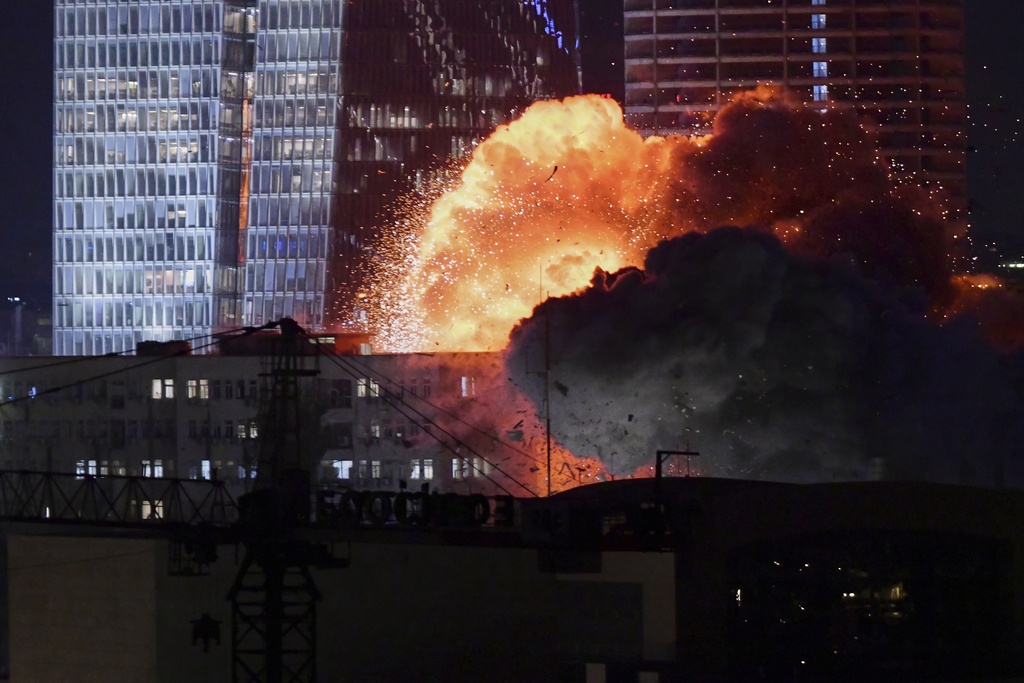Israel's ongoing attacks on Iranian nuclear sites killed 78 people and wounded more that 320 on Friday, said Iran's ambassador to the United Nations. The strikes killed generals and scientists, but the ambassador told the U.N. Security Council that “the overwhelming majority” of victims were civilians.
Iran retaliated with two waves of long-range missiles targeting Israel's commercial capital, Tel Aviv, Medics said the first wave wounded at least 34 people and the second injured seven more.
Israel launched the attacks on Iran amid simmering tensions over Tehran’s rapidly advancing nuclear program. For years, Israel had threatened such a strike and successive American administrations had sought to prevent it, fearing it would ignite a wider conflict across the Middle East and possibly be ineffective at destroying Iran’s dispersed and hardened nuclear program.
As Iranian projectiles and Israeli interceptor rockets left trails of smoke and flame across the night sky on Friday, Iran’s Supreme Leader Ayatollah Ali Khamenei vowed not to let Israel “escape safely from this great crime.”
Iranian media reports a fire at Tehran’s airport
Iran’s semi-official Tasnim news agency is reporting a fire at Tehran’s Mehrabad International Airport, posting a video on X of a column of smoke and orange flames rising from what the outlet said was the airport.
A handful of minor injuries reported from second wave of Iranian missiles
Ichilov hospital in Tel Aviv said it has treated seven people hurt by the second Iranian barrage; six had light injuries and the seventh was moderately wounded.
Iran fires a second wave of missiles at Israel
Sirens and the boom of explosions, possibly from Israeli interceptors, could be heard in the sky over Jerusalem and Tel Aviv early Saturday.
AP journalists in Tel Aviv could see what appeared to be at least two Iranian missiles hit the ground, but there was no immediate word of casualties.
The Israeli military said another long-range Iranian missile attack was taking place and urged civilians, already rattled by the first wave of projectiles, to head to shelter. Around three dozen people were wounded by that first wave.
The Iranian outlet Nour News, which has close links with the paramilitary Revolutionary Guard, said a fresh wave was being launched.
Iranian air defenses are firing against Israeli attacks
The sound of explosions and Iranian air defense systems firing at targets was echoing across the center of the capital, Tehran, shortly after midnight on Saturday.
Additionally, an Associated Press reporter could hear air raid sirens near their home.

How the militaries of Israel and Iran compare
Although roughly equal in the number of troops, the two militaries bring strikingly different tactics and firepower.
Iran boasts a large standing force but also relies on proxies and undercover operations that have been severely disabled in recent months by U.S. and Israeli actions.
Israel, meanwhile, relies on both subterfuge and robust regular ground and air forces that are apparently unmatched in the region.
It’s unclear how long Iran could keep up firing hundreds of ballistic missiles at Israel. However, according to Israeli media reports, the cost of a single Iron Dome interception is about $50,000, while the other systems can run more than $2 million per missile.
Iranian missiles penetrated Israel’s air defenses Friday. How ironclad is the system?
Iran’s long-range missile attack was a stiff challenge for Israel’s air-defense system, which has intercepted projectiles fired from Gaza, Lebanon, Syria, Iraq, Yemen and Iran since the start of the war on Oct. 7, 2023.
Those have ranged from short-range rockets to medium-range missiles to attack drones to ballistic missiles like those fired Friday night.
Over the decades, Israel has developed a sophisticated system capable of detecting incoming fire and deploying only if the projectile is headed toward a population center or sensitive military or civilian infrastructure. Israeli leaders say the system isn’t 100% guaranteed, but credit it with preventing serious damage and countless casualties.
Iranian missiles wounded 34 people in Israel
In Ramat Gan, rescuers were trying to get out 15 people from a house they were trapped in after it was hit by a missile. The city is east of Tel Aviv.
Yossi Griver from Israel’s home front command said authorities were trying to free them. He said people were eating Friday night dinner when their house was struck, and many are older adults.
The area was badly hit Friday night. The AP saw at least three damaged houses, one where the front was nearly entirely torn off, as well as burnt out cars.
What Israel’s attack destroyed at the main Iranian nuclear facility
U.N. nuclear chief Rafael Grossi told an emergency meeting of the U.N. Security Council that Israeli strikes destroyed the above-ground section of Iran’s main nuclear facility at Natanz.
He said all the electrical infrastructure and emergency power generators were destroyed as well as a section of the facility where uranium was enriched up to 60%.
The main centrifuge facility underground did not appear to have been hit, but the loss of power could have damaged the infrastructure there, he said.
US ground-based air defense systems are helping shoot down missiles Iran targeted at Israel, US official says
The U.S. official did not say how the U.S. provided assistance, however both U.S. Air Force fighter aircraft and destroyer-based missile defenses have intercepted missiles in previous attacks.
The U.S. has been moving assets nearer to Israel to assist in missile intercepts and to provide better protection of U.S. bases in the region.
The official spoke on condition of anonymity to discuss ongoing operations.
